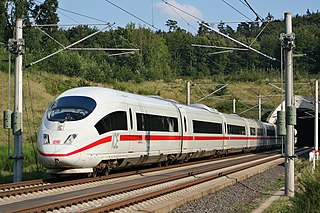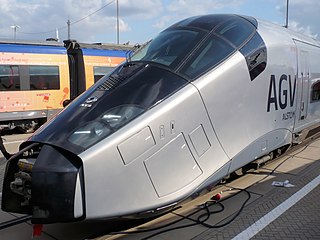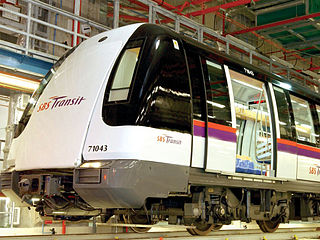
A multiple-unit train or simply multiple unit (MU) is a self-propelled train composed of one or more carriages joined, which when coupled to another multiple unit can be controlled by a single driver, with multiple-unit train control.

The British Rail Class 460 Juniper (8-GAT) was a class of electric multiple-unit passenger trains built by Alstom at Washwood Heath between 1999 and 2001. They were part of Alstom's Coradia Juniper family, which also includes Classes 334 and 458.
The Lancashire and Yorkshire Railway (LYR) built suburban electric stock for lines in Liverpool and Manchester. The line between Liverpool to Southport began using electric multiple units (EMUs) on 22 March 1904, using a third rail 625 V DC. Additional trains were later built for this route, and in 1913 incompatible stock for the route to Ormskirk. Lightweight units were built to run on the Liverpool Overhead Railway.

The British Rail Class 220 Voyager is a class of diesel-electric high-speed multiple unit passenger trains built in Belgium by Bombardier Transportation in 2000 and 2001. They were introduced in 2001 to replace the 20-year-old InterCity 125 and almost 40-year-old Class 47-hauled Mark 2 fleets operating on the Cross Country Route. They were initially operated by Virgin CrossCountry and since 2007 have been operated by CrossCountry.

The London Underground 1960 Stock was a class of electric multiple unit for the London Underground Central line. Twelve motor cars were supplied by Cravens, and pairs were made up to four cars by the addition of two converted standard stock trailers. A production run of 338 motor cars was shelved, due to the time needed to assess the new features and the cost of converting the trailer cars. Some of the pre-1938 trailers were later replaced by 1938 stock trailers.

The British Rail Class 318 is an electric multiple unit (EMU) passenger train which operates in west central Scotland. The units were introduced on 29 September 1986 as part of the electrification of the Ayrshire Coast Line between Glasgow Central and Ayr/Ardrossan with alternating current (AC) overhead lines. Their use was extended to Largs in January 1987. They were also used on the Inverclyde Line in small numbers. The trains currently operate Argyle Line, Cathcart Circle Line, North Clyde Line, Whifflet Line and Inverclyde Line services. Following the withdrawal of the Class 314 fleet in 2019, these units are the oldest working EMUs in Scotland, having been in revenue-earning service for more than 37 years.

An electric multiple unit (EMU) is an electric self-powered train, capable of operating in multiple with other EMUs and without the need for a locomotive; these are typically passenger trains with accommodation in every vehicle and a driving position at each end. The term can also be used to describe a train that is a permanent formation with a non-driving power car, such as the Advanced Passenger Train. As of December 2010, two-thirds of the passenger carriages in Great Britain are formed in EMUs.

The AGV is a standard gauge, high-speed, electric multiple-unit train designed and built by Alstom.

The London Underground 1996 Stock is a type of rolling stock used on the Jubilee line of the London Underground. The trains were built by GEC Alsthom-Metro-Cammell and entered service in 1997. They are externally similar to the 1995 Stock used on the Northern line.

An electric multiple unit or EMU is a multiple-unit train consisting of self-propelled carriages using electricity as the motive power. An EMU requires no separate locomotive, as electric traction motors are incorporated within one or a number of the carriages. An EMU is usually formed of two or more semi-permanently coupled carriages, but electrically powered single-unit railcars are also generally classed as EMUs. The great majority of EMUs are passenger trains, but versions also exist for carrying mail.

ER2 electric trainset is a DC electric multiple unit which was in production by the Railroad Machinery Plants of Riga from June 1962 to mid-1984. It was essentially an improvement of the ER1 design, featuring footboards for low platforms, and aprons for high platforms, as well as improved electrical equipment and minor changes to the bodywork. Since the mid-1960s, the ER2 has been the most widely used type of suburban train in the Soviet Union and its successor states.

The Alstom Metropolis C751A is the first generation of communications-based train control (CBTC) electric multiple unit rolling stock in operation on the North East line of Singapore's Mass Rapid Transit (MRT) system since 2003. 25 trainsets were purchased for the line.

The KTX-Sancheon is a South Korean high-speed train built by Hyundai Rotem in the second half of the 2000s and operated by Korail since March 2010. With a top speed of 305 km/h (189.5 mph), the KTX-Sancheon is the second commercial high-speed train operated in South Korea and the first domestic high-speed train that is designed and developed in South Korea.

The Rhaetian Railway Be 4/4 is a class of 11 kV 16.7 Hz AC metre gauge railcars operating under the traffic numbers 511–516 on the so-called core network of the Rhaetian Railway (RhB), which is the main railway network in the Canton of Graubünden, Switzerland.

The Taiwan Railway EMU100 series was a set of rail cars fabricated by British Rail Engineering Limited and the General Electric Company in 1976 that has operated in Taiwan. The alternating current electric multiple unit (EMU) fleet entered full squadron service in 1979, and was withdrawn from service in 2009. This class of railcars were the first to operate on the electric Tzu-Chiang Express. Due to the unit's British origin, rail buffs have variously nicknamed them "British Girl", "British Lady", or "British Grandma".

The MI 79, also known as the Class Z 8100 is a dual-voltage electric multiple unit trainset that is operated on line B of the Réseau Express Régional (RER), a hybrid suburban commuter and rapid transit system serving Paris and its suburbs. The MI 79, designed in the 1970s for the RER B which needed dual-voltage (interconnection) trainsets. They were followed by a derivative version, the MI 84, designed in the 1980s to meet the needs of the RER A line, before reassigned to the RER B in the 2010s.

The DDJ1 is a first generation high-speed electric multiple unit built for China Railway, built by Zhuzhou Electric Locomotives, Changchun Railway Vehicles, Sifang Railway Vehicles, Tangshan Passenger vehicle factory, Nanjing Puzhen and developed by Zhuzhou Electric Locomotive Research Centre. It was built in 1999, and was an experimental vehicle, with only one set built, as it did not enter mass production. The design was well received as part of national science in the 9th five year plan. The DDJ1 is in a push–pull configuration, with only one locomotive in the set and the other end being a trailer with a driver's cabin.

The NZJ "Lushan", also registered as the NZJ1 are a class of diesel multiple unit (DMU) of China Railway. These sets were built by Tangshan Locomotive in a 2M2T layout of four cars with Cummins diesel engines and Siemens electrical equipment. Three sets were built in total between 1998 and 2000, with two operated by Nanchang Railway Bureau and one by Kunming Railway Bureau.

The DJF2"Xianfeng" electric multiple unit is a model operated formerly by China Railway with traction motors distributed throughout the unit. It was developed in 2001 as a key task of the science and technology targets of the Ninth Five-Year Plan. It was an innovative and advanced design being the first Chinese multiple unit train to achieve 200 km/h (124 mph) and achieving a top test speed of 292.8 km/h (181.9 mph) in tests, but had numerous flaws in the design that complicated operations.

The KDZ1A "Chuncheng" was an early attempt at building an electric multiple unit in China with the participation of Changchun Railway Vehicles, Zhuzhou Institute and Kunming railway bureau. Development was completed in 1999 in time for the Kunming World Horticultural Exposition. As its predecessor, the KDZ1 never operated commercially, the KDZ1A became the first Chinese EMU to be in revenue service, although it was in service for only 10 years before being withdrawn.






















